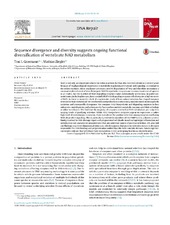| dc.contributor.author | Gossmann, Toni | eng |
| dc.contributor.author | Ziegler, Mathias | eng |
| dc.date.accessioned | 2015-03-20T14:14:24Z | |
| dc.date.available | 2015-03-20T14:14:24Z | |
| dc.date.issued | 2014-11 | eng |
| dc.identifier.issn | 1568-7864 | en_US |
| dc.identifier.uri | https://hdl.handle.net/1956/9604 | |
| dc.description.abstract | NAD is not only an important cofactor in redox reactions but has also received attention in recent yearsbecause of its physiological importance in metabolic regulation, DNA repair and signaling. In contrast tothe redox reactions, these regulatory processes involve degradation of NAD and therefore necessitate aconstant replenishment of its cellular pool. NAD biosynthetic enzymes are common to almost all speciesin all clades, but the number of NAD degrading enzymes varies substantially across taxa. In particular,vertebrates, including humans, have a manifold of NAD degrading enzymes which require a high turnoverof NAD. As there is currently a lack of a systematic study of how natural selection has shaped enzymesinvolved in NAD metabolism we conducted a comprehensive evolutionary analysis based on intraspecificvariation and interspecific divergence. We compare NAD biosynthetic and degrading enzymes in foureukaryotic model species and subsequently focus on human NAD metabolic enzymes and their orthologsin other vertebrates. We find that the majority of enzymes involved in NAD metabolism are subject tovarying levels of purifying selection. While NAD biosynthetic enzymes appear to experience a ratherhigh level of evolutionary constraint, there is evidence for positive selection among enzymes mediatingNAD-dependent signaling. This is particularly evident for members of the PARP family, a diverse proteinfamily involved in DNA damage repair and programmed cell death. Based on haplotype information andsubstitution rate analysis we pinpoint sites that are potential targets of positive selection. We also linkour findings to a three dimensional structure, which suggests that positive selection occurs in domainsresponsible for DNA binding and polymerization rather than the NAD catalytic domain. Taken together,our results indicate that vertebrate NAD metabolism is still undergoing functional diversification. | en_US |
| dc.language.iso | eng | eng |
| dc.publisher | Elsevier | en_US |
| dc.rights | Attribution CC BY | eng |
| dc.rights.uri | http://creativecommons.org/licenses/by/3.0/ | eng |
| dc.subject | NAD metabolism | eng |
| dc.subject | positive selection | eng |
| dc.subject | pathway evolution | eng |
| dc.title | Sequence divergence and diversity suggests ongoing functional diversification of vertebrate NAD metabolism | en_US |
| dc.type | Peer reviewed | |
| dc.type | Journal article | |
| dc.date.updated | 2015-03-04T09:58:28Z | en_US |
| dc.description.version | publishedVersion | en_US |
| dc.rights.holder | Crown Copyright 2014 | en_US |
| dc.identifier.doi | https://doi.org/10.1016/j.dnarep.2014.07.005 | |
| dc.identifier.cristin | 1216540 | |
| dc.source.journal | DNA Repair | |
| dc.source.40 | 23 | |
| dc.source.pagenumber | 39-48 | |
| dc.subject.nsi | VDP::Mathematics and natural scienses: 400::Basic biosciences: 470::Genetics and genomics: 474 | en_US |
| dc.subject.nsi | VDP::Matematikk og naturvitenskap: 400::Basale biofag: 470::Genetikk og genomikk: 474 | nob |

